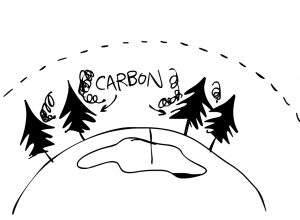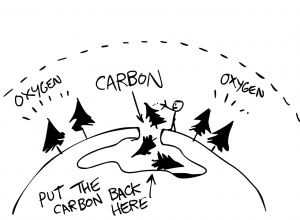
Primitive species turned carbon from Earth’s earlier, carbon-rich atmosphere into more of themselves:
early primitive life (procaryote cells) modified our planet by converting CO2 and H2O to organic matter and releasing oxygen to the environment. As a consequence these organisms moved carbon from the atmosphere to the rocks (Figure 11) and broke down water molecules releasing oxygen to the ocean and eventually to the atmosphere. Life therefore is a powerful force controlling the composition of the Earth’s atmosphere which in turn exerts a powerful control on our planet’s climate. http://eesc.columbia.edu/courses/ees/climate/lectures/earth.html
Now we’re taking that carbon out of the earth and spewing it back into the atmosphere…

…creating a climate suitable for bacteria and prokaryotes, but not for the complex life forms we cherish today (such as ourselves).

To restore climate balance, we must put carbon back into the earth.
We should throw carbon into large holes, cover them up with layers of rock and soil, and allow them to compress for millions of years, over which time they will again form a viscous underground carbon sludge safely distant from our preferred oxygen-rich air.

In other words, we should be putting our carbon waste (paper and plastic) in landfills. Not recycling them.

Paper comes from tree farms, which are carbon sinks. In an ideal climate-restoration system, farmed trees would fix atmospheric carbon, become paper, and get buried back into the ground, with earthbound carbon accumulating every year as atmospheric carbon diminishes. By this logic, the junk mail industry is helping the environment, as it converts atmospheric carbon to bury-able waste, paid for entirely by advertisers.
Plastic is made of carbon humans dug up from deep within the Earth as petroleum. If it’s buried it can become petroleum-like again in several million years. If petroleum is burned as fuel, more carbon goes into the atmosphere. Petroleum is more valuable as a plastic source than as a fuel; solar energy can power vehicles but it can’t become plastic (without the intervention of billions of years of photosynthesis and compression).
So bury your paper and plastic (carbon) waste. Bury it in a good landfill.
But recycle metal. It’s much more efficient than mining anew. Metals aren’t carbon. And recycle glass. It’s silicon, not carbon.
Based on numerous conversations with Theodore Gray.
Note: none of this is going to fix the world. We’re all doomed for many reasons. It does however take some air out of the sails of “recycling paper and plastic helps the Earth!!!” The ritual of recycling paper and plastic is mostly just that – a ritual which eases denial of environmental catastrophe in progress. I’m suggesting we can abandon that ritual now.
Update from Theo* (via email):
The thing everyone keeps missing is that none of that matters. The only thing you have to understand is that ALL carbon that can be dug out of the ground in any form, will be. The economic pressure to do so is simply overwhelming, and no one is going to be able to stop it. The ONLY question is whether it will be burned, or made into plastic and thrown away (which keeps it out of the atmosphere).
And the only thing that matters in answering that question is whether there is more money to be made in burning it, or in making it into plastic. What is the relative price of fuel vs. feedstocks for plastic, and what is the relative demand for fuel vs. for plastic. Right now it’s evenly enough matched that a lot goes into both, but if something tips the balance towards it’s being worth much more for plastic, there would be a massive worldwide switch away from burning it. No need for demonstrations, it would just happen.
Things that can tip the balance in that direction are:
- Cheaper alternatives for fuel, so wind power, hydrogen from solar, etc, etc.
- Things that increase demand for plastic.
It’s in item number 2 that recycling comes into play. If you recycle paper, that lets people make more paper packaging instead of using plastic. If you recycle plastic, that keeps it out of the landfill (where it belongs and can do some good) and returns it to the market to compete with virgin plastic, thus reducing the demand for oil to make new plastic, thus diverting more carbon into the atmosphere.
Burying paper also has the side effect of removing even more carbon from the air because it’s made out of carbon from the air, but that’s only one reason for doing it. Helping increase the price of plastic is at least as important a reason.
No questions about how much fuel it takes to do any of these things is relevant. The fuel is going to get burned. Exponential growth has no mercy: The carbon IS going to be dug out of the ground, nothing can stop that, all we can do is try to re-bury as much of it as fast as we can.
*Please note Theo’s opinions are his own; I’m sharing them here because I think they’re interesting and worth discussing.

This is reasonable in some sense, but the real question goes back to burning up the fossil fuels. I don’t know the details, but it is, in principle, possible that most of what goes into making paper is burned up energy, generally from fossil-fuels. The same energy is also used in the process of recycling.
So it may be the case that recycling paper is so much more efficient than making new paper that the savings in less fossil fuel use outdoes any impact of landfilling the paper vs harvesting trees. It may also be the case that letting a tree sit living longer absorbs as much or more carbon than cutting it down and planting a new one. It may be the case that tree farms are otherwise inefficient and require massive amounts of energy to run. I’m not sure about any of these details.
The basic thing is: recycling is definitely questionable. It is not good whenever recycling is really inefficient. But if it is efficient, especially compared to the alternatives… Well, so there are definitely examples where it’s better to make new than to recycle, but I don’t know the proportion of those situations to those where recycling is net better.
What we definitely know is that the junk-mail industry mostly involves a lot of heavy things being shipped around in fossil-fuel burning vehicles. That might be the biggest energy use.
The real irony is that any reduction in fossil fuel use just helps keep the price down so that other people wasting it on oversized SUV’s and oversized McMansions and sprawl can keep doing those things. The only answer that I see is to keep shaming people to where we cut this out just because… but we’re probably just screwed.
Anyway, I decided to search a little, and, here’s the EPA’s approach (looks surprisingly good): http://www.epa.gov/epawaste/conserve/tools/warm/index.html
Among many factors, they actually include landfills as carbon sequestors just as you describe, but they say it’s complex, see: http://epa.gov/climatechange/wycd/waste/downloads/landfill-carbon-storage-in-warm10-28-10.pdf
So without going into the details of each case, it’s still hard to say. Consuming more and making more trash is probably not a good idea if we have to have some guideline…
Wow.
Does the math actually work out? Say, does the amount of energy I burn (== carbon I “un-fix”) to put stuff back in the earth come out to significantly less than what I put back in the earth?
Young growing trees are good carbon sinks, old trees are poor sinks or even sources as they return carbon back to the environment as they mature, decay and die. Also, landfill can work if done properly i.e. sealed under impermeable layers as you suggest but anaerobic digestion of organic material can lead to the production of methane which is a much worse greenhouse gas than carbon dioxide.
You’re right of course in saying that ultimately the carbon extracted from the ground (oil, coal and gas) must be returned there in one way or another otherwise it will end up in the atmosphere and oceans where it can do more damage.
Nice illustrations, by the way!
The problem is that you need wast amounts of land to grow all the plants and trees. The amount of carbon in garbage is almost neglectable. And one would also have to replace the energy that comes from burning garbage by some other means.
Watch Matt Ridley on how bio fuel hurts wild life and how CO2 makes the world greener:
https://www.youtube.com/watch?v=S-nsU_DaIZE
@Karl, I’m sure dumping paper and plastic in landfills burns far less carbon fuel than recycling it.
@Khurram: Young carbon trees are exactly what the industrial tree farms supply. I detest the destruction of old-growth forests by tree industries, and I abhor the junk mail industry, but from an atmospheric viewpoint they could be working to transfer carbon from the air into the ground (as long as we don’t divert the waste paper into recycling). Theo imagines junk mail as “sponsored carbon sinking.” This doesn’t address the mental pollution of the advertising, but this whole argument is only about atmospheric carbon.
Hi Nina. Thanks for the update.
≈ Most tree farms are unsustainable in that they deplete the topsoil. Tree farmers favor quick-growing softwoods and compensate for rapid growth with petroleum-based fertilizers. Forest ecosystem undergrowth is suppressed with petroleum-based pesticides, and with nothing growing to hold the soil together, the whole mess runs off into the oceans. (Perhaps mulching paper back into tree farms would help, but I don’t know of any such schemes.)
These considerations, in addition to the destruction of virgin forest, is why ecologists pushed for paper recycling in the first place. It is only intermittently profitable, so for some decades the deal was that metal and glass would pay the way for paper.
The entire equation was wrecked with the introduction of plastic downcycling. By calling it “recycling” and embedding chasing-arrow symbols on all plastics, the industry fooled the public and won marketplace acceptance. Landfilling it won’t help (most “recycled” plastic is actually landfilled anyhow) because the real issue is that their false economy derives from their being a byproduct of the petroleum fuel industry, which is the far bigger problem.